The ocean holds many secrets; every once in a while, she shares a little bit.

Group of bumphead parrotfish (Bolbometopon muricatum)
spawning in the early morning
I have been fortunate in this regard, having had opportunities to witness more than my fair share of amazing spectacles in the sea, such as the scene pictured above, of bumphead parrotfish (Bolbometopon muricatum) engaged in a orgy of spawning.
Quite often, when I post photos like this, I receive emails reflecting the sentiment: "You b*stard! Some people have all the luck," or other missives along similar lines.
Good fortune is, of course, always important, but there's a lot more that goes into being in the right place at the right time with the right knowledge, right equipment, and right people. There's usually a lot of preparation, work + trial-and-error involved...and not just by me. In most cases, I am dependent upon the efforts, observations and assistance of many dedicated friends.
My quest over the course of 2012 to capture photos of massive spawning aggregations involving thousands of fish is a perfect example.
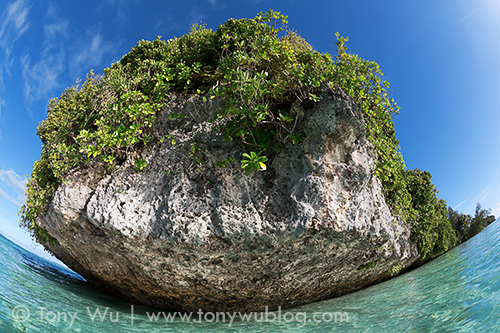
Close-up view of one of Palau's many beautiful Rock Islands
If you've been reading my blog for a while, you might remember that I had the chance to get reacquainted with Palau early in 2011 (see previous post, Exploring Palau by Kayak).
The trip was a fantastic experience in itself, but that visit to the beautiful island nation also opened my eyes to the wealth of untapped opportunity there.
Allow me to explain.
Palau is by no means a secret, at least not among the diving community. World-renowned sites like Blue Corner, the Blue Holes, German Channel and many more are a fundamental part of the global diving lexicon.
This is the very reason that I chose to give Palau a pass for many years.
You see, as a full-time photographer, I strive to stay ahead of the curve. I tend to choose remote locations, difficult subjects, places that haven't been thoroughly explored by the underwater community. With so many camera-carrying divers visiting Palau each year, all diving the same sites day-in and day-out, there were few opportunities, I reasoned, for me to capture unique images.
Please don't misunderstand. I've never had a bad opinion of Palau; I've often recommended it as an ideal destination to friends looking for a nice holiday. The marine life is amazing, and the dive sites among the best in the world.
What caused me to re-evaluate my own interest back in 2011 though, was the multitude of unexplored territory...the vast areas in between and outside the standard dive sites that are virtually ignored by the recreational diving community.
In short, I saw potential.
My kayak adventure with Ron got me thinking: "Hmmm, I wonder what else is around?" And, as often happens when I start to ask questions, a cascade of queries and communications followed, which eventually led to my devoting a significant chunk of time last year (about 45 days) to photographing a plethora of procreating piscines.
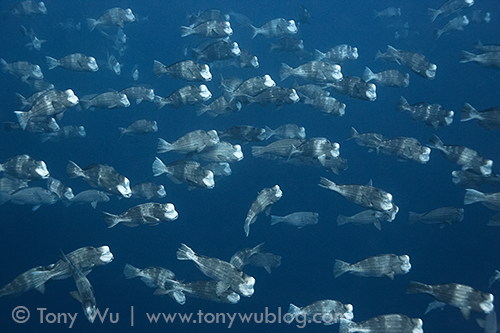
Bumphead parrotfish (Bolbometopon muricatum)
amassing in deep water prior to spawning
Blue Marlin
Before I get too stirred up about titillated fish, let me back up a step.
As I mentioned above, successfully capturing amazing images often involves the help and cooperation of many parties. In this case, I worked with a dive operation in Palau called Blue Marlin.
Most of you reading this are probably not familiar with Blue Marlin. It is a Japanese dive shop, located at the Palau Royal Resort.
So you might be wondering why I chose to work with a Japanese dive shop.
The reason is simple: The team at Blue Marlin discovered and documented the bumphead parrotfish spawning aggregation.
Blue Marlin is well-established in Palau, catering almost entirely to divers from Japan. A few years ago, the team took the initiative to start looking for new dive sites to show their repeat clientele. I'm sure this was partly driven by the realities of competition with other Japanese-owned dive operations in Palau, but having spent considerable time last year with my friends at Blue Marlin, I am also certain that curiosity and an eagerness to learn and explore were among the precipitating factors.
In any event, the Blue Marlin staff noticed several years ago that they frequently came across significant numbers of bumphead parrotfish at one of the dives sites they took their customers to for early morning dives, a site they pioneered and dubbed Grassland (in reference to fields of garden eels waving in the sand like grass being brushed by wind).
For many months, members of the Blue Marlin team went out to survey activity at Grassland whenever circumstances permitted, trying to work out what, if anything was going on.
To cut to the chase, after much methodical exploration, they realised that they had stumbled upon the staging area for a spawning aggregation involving thousands of bumphead parrotfish, an event the likes of which has never been documented anywhere else in the world (at least as far as I know).
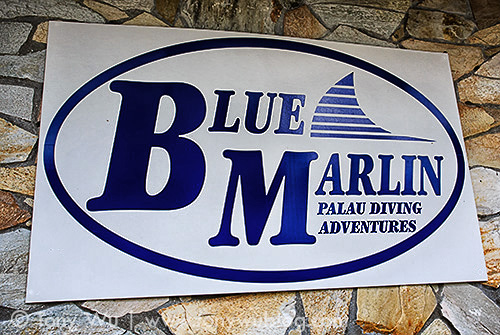
Blue Marlin dive shop in Palau
Procreating Piscines of Palau
Bumphead parrotish are big. They grow to over one metre (> four feet) in length, and can weigh up to something on the order of 45kg (about 100lbs).
To see a few on a dive is quite a sight; to see hundreds, even thousands, gathered for a mating frenzy is truly a spectacle to behold. The nearest analogy I can think of in terms of visual impact is the annual wildebeest migration that takes place on the plains of east Africa.
Just imagine, if you can, being in the midst of rampaging herds of wildebeest. That's sort of what it's like to be among the bumpheads when they are spawning. Sprinkle in the occasional bull shark ripping through groups of hormone-frenzied fish spewing opaque clouds of sperm and eggs...and you get the idea.
It's jaw-dropping amazing.
Now...it's one thing to know that the spawning aggregation takes place; it's another thing entirely to figure out the exact location and timing in order to be able to hit it just right every time. Just heading over to the dive site and dropping in would most likely result in seeing exactly zip.
That's where my friends at Blue Marlin proved critical to my efforts.
After many, many hours of study, they were able to work out the specifics to be able to predict with reasonable accuracy the time and place of this spawning event. They now know that the spawning takes place once a month, with the extent and duration of activity seemingly dependent upon (and varying somewhat with) the timing of tide and direction/ intensity of current.
If you're interested in seeing this event and/ or trying to photograph it (obviously you are if you've read this far), here's what you'll need to be prepared for:
First, you'll need to wake up early. The exact timing varies, but generally speaking, you'll need to head out at or before sunrise. Yes, it's painful, but the fish are on a schedule and they won't wait for late risers.
Next, it's best if you're in decent shape. In the beginning, hundreds, sometimes thousands of fish will gather from all different directions. During this phase, the fish are pretty laid back, so you can chill while you observe.
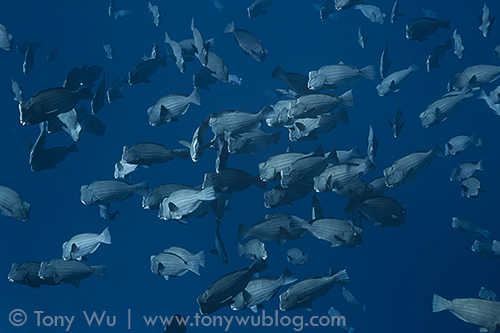
Bumphead parrotfish gathering in the early morning,
before their faces turn white
At some point, however, it'll be as if someone flips an "on" switch, and the fish will go berserk. You'll be able to see this coming when their faces start to turn white, but you won't be able to predict exactly when the chaos will begin.
There are often several false starts and stops, during which hundreds of fish move together at speed in one direction, over quite a wide area. Most of the time, visibility is limited.
So the pickle you'll find yourself in is that you'll need to swim to keep up with the fish in order to see what they're doing, but the more fish feints there are, the more air you'll use, and the less time you'll have in the water once the bumpheads actually commence spawning.
Also worth noting...the preliminary action often takes place at depth, in some instances down to 30m or more. This varies depending on ambient conditions. Once the main event starts though, the fish tend to rush toward the surface, so it will be vital to monitor your depth and ascent rates at all times.
The bottom line is...the better shape you're in, the better your chances will be of (a) keeping up with the fish, and (b) having reasonable air consumption while biding time before the main event.
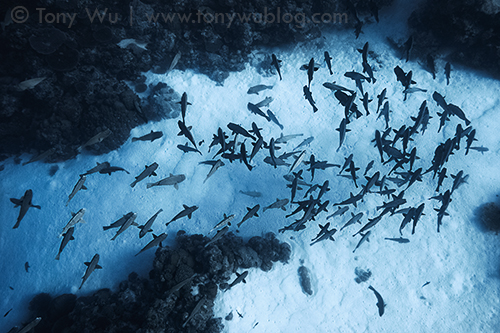
Bumphead parrotfish gathering in the early morning before spawning
And finally, when the action starts, things tend to happen really, really fast. Spawning groups coalesce without obvious warning from the amorphous mass of fish milling about, then shoot toward the surface at lightning speed, releasing streams of white jizz along the way. At the apex of their amorous runs, they split and plummet back down to the main congregation below.
The bumpheads often change directions en masse, meaning that it's relatively easy to lose sight of them in the gamete-laden water. If you get separated from the fish, it can be surprisingly difficult to relocate them, given how many there are. Fish jizz is difficult to see through, which exacerbates limited visibility due to low light and suspended particles already in the water.
The best advice I can offer is to stick close to the guide, whom I'll introduce later. You can choose to rely on his experience and judgement (which would be the intelligent thing to do); or you can decide that you know better and go rushing off into the blue (which would be boneheaded and just about guarantee that you miss the action).
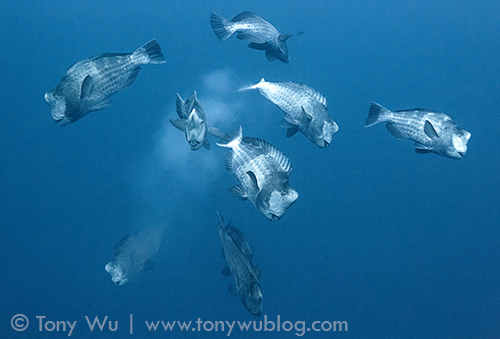
Horny bumphead parrotfish going off like an aquatic fireworks display
Oh...one thing to keep an ear out for. Yes ear, not necessarily eye.
The bumpheads have oversized foreheads for a reason. The males headbutt each other from time to time, most likely for the same reason males of other species headbutt one another (no need to explain, right guys?).
I've seen it once up close, with two males lining up, speeding off in opposite directions for a few metres, whipping around in a sudden, simultaneous 180, then slamming head-first into each other at full speed...resulting in a tremendous "THWHACK!" that resonated throughout the entire Pacific basin, probably beyond. Ouch.
Chances are you won't see it happening, but if you're in the water while the spawning is taking place (and assuming you're paying attention), chances are good that you'll hear it.
There's no mistaking the sound of two hormone-hyped bumpheads barreling into each other full throttle. (Incidentally, that's why I prefer to use the term "bumphead" over "humphead" for the colloquial name.)
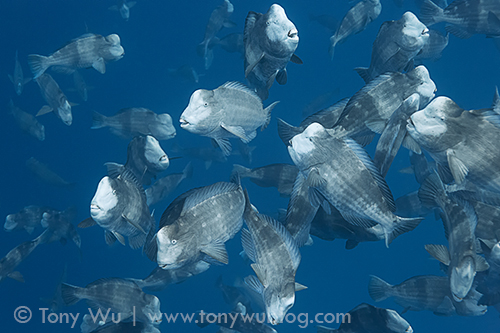
When the bumphead parrotfish are ready to spawn,
their faces take on the pale colouration shown here.
Next Up
My friends at Blue Marlin helped me to nail photos of mass spawning of a second species as well, Lutjanus bohar, or twin-spot red snappers.
I'm going to split that description and set of photos out into a second post.
Like the experience of witnessing the spawning bumpheads, seeing thousands upon thousands of red snappers (which, incidentally, I noticed are not always red) was a sight for which words are entirely inadequate.
Finally, I'm planning to describe Blue Marlin in greater detail in a third post, introducing some of the key people, and telling you about my experience of diving with them, so please check back in the next few days.
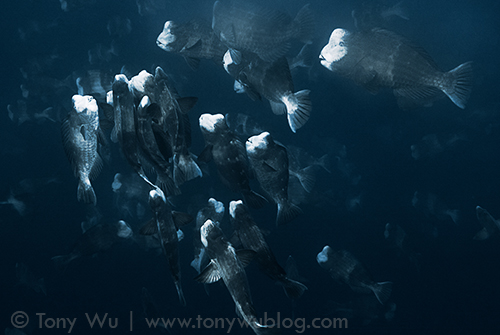
Early morning fish sex in deep water
Related Posts:
Part 2: Lutjanus bohar Two-spot Red Snapper Spawning Aggregation in Palau
Part 3: Diving with Spawning Aggregations in Palau